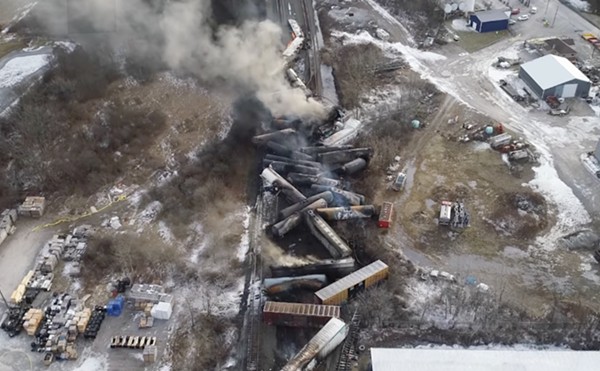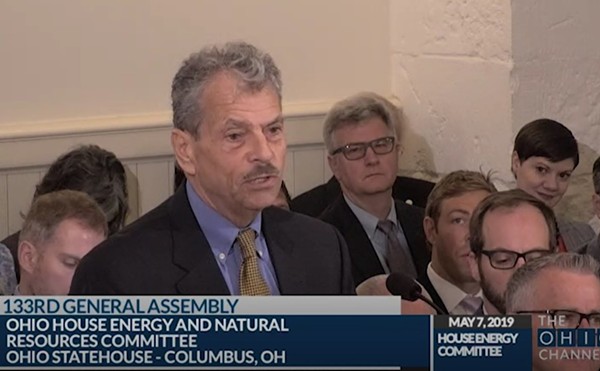After 10 grueling weeks of trial, 76 witnesses, hundreds of exhibits, and a small mountain of evidence, the Sheppard case came down to a single hushed moment in the courtroom of Common Pleas Judge Ronald Suster last week. Just five and a half hours earlier, at 11:30 a.m., Suster had concluded his instructions to the jury and sent them off to begin deliberations. Lawyers, reporters, and Sheppard supporters broke for lunch and the long wait for a decision.
But by 4:30, the verdict was in. Suster's courtroom quickly filled with prosecutor's office employees anxious to witness history. The principals filed in at 5, both sides looking confident, smiling to hide their tension. The Sheppard entourage arrived carrying a large framed picture of a loving Sam and Marilyn Sheppard, ready to punctuate the vindication of Dr. Sam.
Suster kept the courtroom waiting, as he had the entire trial, and the buzz of anticipation rose to a ballpark pitch. It dropped to total silence when Suster finally took the bench, looking grim. The lightning-like decision had surprised him as much as anyone, and over the next few days, he privately confided his disappointment over the jury's apparent haste.
The verdict was presented pro forma, on a written ballot to the judge, who paused dramatically and then announced, "The jury finds for the state." The news hadn't quite sunk in before prosecutors asked Suster to poll the jury, with devastating results. Every one of the eight jurors had voted the same way. After a decade-long investigative, legal, and public relations campaign, the Sheppard team was unable to convince a single person of Dr. Sam's innocence.
Sam Reese Sheppard never broke his courtroom demeanor: a steady, slightly bemused reserve that he maintained through even the most wrenching testimony. It was his lawyer, Terry Gilbert, who, with a sidelong glance at the television camera, took off his glasses and broke into tears. "We're OK . . . we're OK," Gilbert assured the throng of reporters assembled in the hallway afterward, sounding more like he was trying to convince himself of that fact.
Gilbert had been equally emotional in his closing arguments the previous day. "All we ask of you," he begged the jury, "is to bring some peace and closure to this family. Give us justice. Please." Gilbert's plea touched hearts if not minds, evident in the female juror who left the courtroom in tears after delivering the bad news to Sam Reese and his family and friends.
County Prosecutor Bill Mason and his team struck a surprisingly subdued note at their press conference, looking less like victors than exhausted surgeons glad to be finished with a long and difficult operation. Their workmanlike approach culminated in tag-team closing arguments from Mason and Chief Trial Counsel Steve Dever that reduced the vaunted Sheppard DNA evidence to "mumbo jumbo" and posed common-sense questions, some decades old: Why were there no fingerprints at the crime scene? What happened to Dr. Sam's T-shirt? And where was the family dog?
"It was Matlock-type stuff," Dever said afterward, and it worked -- not because the trial was held "in the belly of the beast," as Sam Reese complained in the post-trial press conference, or in the shadow of any enduring prejudice. The Sheppard team lost, quite simply, because they could not make a convincing case for Dr. Sam's innocence. Their evidence looked a lot more persuasive in headlines over the past few years than it did in the courtroom, where their science was inconclusive and their case against suspected killer Richard Eberling was reduced to innuendo.
But while Sam Reese was a loser in court, he came out a winner on the streets of Cleveland, where a citizenry 46 years removed from the trauma of his mother's murder identified with his quest for resolution and responded from the heart. It was rare for Sheppard to be out in a restaurant, or at a public gathering, and not be approached by a stranger who would recount an obscure connection with the Sheppard case and wish him well. On Friday, when he showed up at Jacobs Field for the Opening Day protest against Chief Wahoo, Sheppard was greeted with sympathetic hugs and applause.
It was an odd coda to a punishing ordeal. The third Sheppard trial turned out to be less a legal exercise than an emotional marathon, a parade of witnesses ancient or expert or dead, a tedious series of stops and starts with brief flashes of scandal and weirdness, and a painful revisiting of troubled lives that ended in a horrible event.
For Mason & Co., the trial was an opportunity to cut through all the hype and publicity that had carried the case, strip it down, and finally put it before a jury -- which they did in force. For the outgunned Sheppard team, it was less a case than a cause, a banner to carry and a struggle to wage in the name of justice and legal reform. It was a powerful message that played very well.
Except to the eight people who got to hear the facts.
A Parade of Suspects
"I don't want to be overconfident. But we're a third of the way through their case, and they've got nothing so far."
It was February 18, three weeks and 11 witnesses into the trial. The conference table in Bill Mason's ninth-floor Justice Center office was a riot of paperwork and files, the product of 11 months' work on the Sheppard case. Mason had three assistant prosecutors -- Steve Dever, Dean Boland, and Kathleen Martin -- helping him prepare and present the case, and two other staffers -- Marilyn Cassidy and Andy Nichol -- doing legal research.
So Mason was more than ready when opening statements were made, after a slew of opening motions had been decided and a jury selected. The lines of demarcation seemed clear: Terry Gilbert and George Carr, representing the Sheppard estate, had the burden of proving that Dr. Sam did not murder his wife and was wrongfully imprisoned by the State of Ohio. County prosecutors, representing the state, would defend the 1954 conviction of Sheppard, which was subsequently overturned by the Supreme Court.
Gilbert was in trouble before he started. To prove Dr. Sam innocent, he had developed a two-prong strategy. First, he would portray Sheppard as a decent man incapable of murdering his wife, the victim of a biased investigation. Second, he would use DNA evidence to show that another person was in the Sheppard home the night of Marilyn's murder -- specifically, Richard Eberling, a handyman and sneak thief later convicted for the murder of Ethel May Durkin, a well-to-do Lakewood widow.
But on the eve of opening testimony, Judge Suster effectively shut down the Eberling strategy, ruling most of the material about him inadmissible. Gilbert had developed an elaborate history of Eberling as a multiple personality and serial killer, and had a witness ready to testify that he confessed to killing Marilyn. The witness was fine. But until and unless Gilbert could tie Eberling directly to the Sheppard crime scene, nothing else could be said about him.
"You're taking the whole gut out of our case," Gilbert complained to Suster. He backpedaled when reporters questioned him afterward, and for weeks afterward both he and Sam Reese insisted that their case was not about convicting Eberling, but clearing Dr. Sam. Nevertheless, as the trial unfolded, it was clear the Eberling loss was critical.
Gilbert tried to replace him with a grab bag of suspects. He led off with F. Lee Bailey, the publicity-mongering attorney who won an acquittal for Dr. Sam in 1966. Bailey made a big splash, asserting that the state withheld key evidence from him. But he threw a weird curve into the case by resurrecting Spencer and Esther Houk as suspects.
Houk, the mayor of Bay Village in 1954, was a friend and neighbor of the Sheppards and the first person Dr. Sam called the morning of the murder. Both he and his wife were questioned in the initial investigation, but never considered as serious suspects. When Bailey took on the case 12 years later and needed someone to deflect guilt from Dr. Sam, he raised the specter of an affair between Spencer Houk and Marilyn. When Esther learned of the affair, Bailey conjectured, she killed Marilyn in a jealous rage.
The Houk theory has been disproven time and again, and showed nothing so much as how out of touch Bailey is. But now the jurors had two alternative suspects -- Houk and Eberling, named by Gilbert in his opening statement. And to complicate matters further, Bailey insisted that Eberling couldn't be the killer.
Later in the trial, Gilbert introduced a third suspect, Henry Fuehrer, a vagrant passing through Cleveland at the time of the murder who told Bay Village police that he and a drinking buddy had decided to rob a suburban home. Fuehrer balked when they pulled up to the Sheppard house, but after his friend went inside, he heard sounds of a struggle and fled. His story turned out to be a hoax -- when Cleveland police investigated, they found that Fuehrer was in a Tennessee workhouse the night of the murder.
But Gilbert took an elaborate detour with Fuehrer, bringing witnesses up from Knoxville to testify that they could find no mention of him in prison records. "You were probably wondering where I was going with that," Gilbert said to the jury in his closing statement -- and in truth, it was never clear. Fuehrer was a liar, Bailey was misguided, and the parade of suspects never added up to one tangible intruder at the crime scene.
Even some of the character witnesses were counterproductive. Mims Adler, a family friend, testified on videotape that she talked to Marilyn the night before the murder and found her happy and excited about being pregnant. But on cross-exam, Adler also recalled a 1953 Halloween party at which Dr. Sam danced with other women so much that Marilyn complained, "There's the Playboy of the Western World."
Gilbert scored an early and solid hit with Dr. William Fallon, a trauma specialist from MetroHealth, who examined the medical records of Dr. Sam and said his injuries could not have been faked or self-inflicted. There's no question Sheppard was beat up the morning of the murder; numerous accounts describe him as bruised and groggy. But the precise nature and extent of his injuries were hotly contested during the trial.
Gilbert portrayed them as the result of Dr. Sam's struggles with the legendary bushy-haired intruder, and the basis for his vague and spotty memories in subsequent interviews and trial testimony. Prosecutors said he was hurt in a life-and-death fight with his wife, and that his brother, Dr. Stephen, used the injuries as an excuse to whisk Dr. Sam away to Bay View Hospital and try to shield him from the police.
Fallon's testimony didn't worry Mason. "We have a medical expert coming who's going to say just the opposite, so that's a wash," he said.
Mason's cool disposition that afternoon gave no indication that the rancor bubbling below the surface of the trial had just burst into public view. The undercurrent of tension in the courtroom was partly the result of months of behind-the-scenes sparring between Gilbert and Mason prior to the trial, and partly the product of lingering resentment.
"I didn't really feel comfortable in that courtroom," admits Dever, a 15-year veteran who has tried cases against Gilbert in the past. "There wasn't the type of civility that you usually have. I felt there was a lot of anger and hostility focused in on us, because we represented all the sins of the past."
Sam Reese refused to shake hands or talk with the prosecutors, whom he was calling "persecutors" by the end of the trial. "Would they have shaken hands and buddied up to my dad?" he asked. Gilbert, whose courtroom manner ranges from excitable to overheated, was given to periodic outbursts and barbs like "They're [the prosecutors] looking for dirt -- I'm looking for the truth."
The spark that set off the public tiff was a seemingly harmless question at a Friday afternoon press conference about the possibility of settling the case. "I'm a very reasonable person," Mason said. "I'm always willing to talk."
He had barely stepped away from the microphone when Gilbert jumped up and said, "There's never been any good faith effort to resolve this case. We spent a week preparing a settlement proposal, and it was shot down. I'm not upset, but I want the reality known."
It was true that Mason hadn't taken the proposal seriously -- because, among other things, it suggested a financial settlement of $3.2 million, a figure he regarded as ludicrous. He was initially inclined to laugh off Gilbert's outburst. But after the Sheppard team spent the next three days complaining to the media about his duplicity, Mason decided to retaliate.
During the lunch break Tuesday, he revealed the settlement figure to reporters. When the afternoon session convened, Gilbert was seething. "I'm not going to ask for a mistrial, because I want this trial to move forward," he fumed. "But I want a strong admonishment." Suster, clearly displeased, reprimanded Mason and spent the next morning polling the jurors to see if any of them had been influenced by the news.
"Sometimes you do things in the heat of battle that you wonder later if you should have done," Mason said afterward. "They had spent the whole weekend spinning that thing, and I have the absolute right to clear it up. But we didn't need the sideshow it created. There's enough stress in the trial as it is."
Particularly for Sam Reese, who was in the middle of a full day of testimony when Mason dropped his bombshell. For weeks afterward, Sheppard complained bitterly about Mason's maneuver, which reinforced his paranoia about the Cuyahoga County justice system.
Even the day-to-day business of the trial was contentious, with both sides challenging every bit of the opposing evidence and testimony. Suster spent much of his time listening to evidentiary arguments and determining what was admissible, making rulings so complicated that witnesses often sat idle while lawyers gathered at the bench for clarification.
As a result, the trial moved at a glacial pace, particularly for the jurors, who were not allowed to hear many of the arguments. It was not unusual for them to spend most of their day in the waiting room, then be called in for 45 minutes of testimony. Some days, they were sent home without hearing a single witness.
"The judge across the hall asked me how it's going here," Suster said one morning. "I said, "I'll tell you. When somebody says "good morning," it starts an argument.'"
He Blinded Them With Science
"It's been a great relief to finally present our DNA evidence in a court of law. The world now knows that someone else was in the house that night."
Sam Reese was in an upbeat mood on March 8, sitting for a brief press conference after the Sheppard team rested its case. Not everyone shared his opinion about the persuasiveness of the DNA evidence -- but for him, simply getting it in the legal record was a milestone. And there was no question that Gilbert's efforts had picked up steam.
He brought in Kathie Collins Dyal, a former home health care worker for Ethel May Durkin, who testified that she was talking to Richard Eberling at Durkin's house one night when he confessed to Marilyn Sheppard's murder. "He told me that he killed her and that he hit her husband in the head with a pail and that "the bitch bit the hell' out of him," she said.
Even Mason was impressed. "I think that's the best witness they've put up so far," he said afterward. "We're going to have to find a way to deal with that." Several weeks later, he brought in Dyal's ex-husband, who testified that she never told him about Eberling's confession until it held the possibility of a book deal and television appearances.
The nut of the Sheppard case was a series of expert witnesses, beginning with a forensic psychiatrist named Emanuel Tanay. He had done an exhaustive psychoanalysis of Eberling and was prepared to give him star billing as the likely killer. But he never got the chance. Suster restricted his testimony to a general discussion of homicides and the particulars of the Sheppard murder scene.
"They tied my hands," Tanay complained after his testimony, parts of which seemed designed to bolster the opposition's case. After a brief Psych 101 lecture, he launched into a description of an "egoestonic homicide," which neatly answered the question, "How can a law-abiding person kill someone they love?" By the time Tanay finished his diagrams on a display board, it was clear how the stresses in a marital relationship can lead to a sudden explosion of rage.
But Tanay saw something else in the Sheppard murder -- a sexual sadist, a "monster" who tortured a helpless, pregnant woman for his own twisted pleasure. Dever tried to move him off that in cross-exam, but Tanay stood firm. "How many times do I have to say this? This was not a domestic homicide. No normal human being would do this."
Barton Epstein, a bloodstain expert, took the stand to explain why the killer would have been covered in blood (the savage beating sprayed blood all over the bedroom) and, after being cut in the struggle, left a large splotch of his own blood on a closet door. Dr. Sam had virtually no blood on him that morning, but Dever dismissed that easily in cross-exam by pointing out that he could have changed clothes.
The stain on the closet door seemed problematic, until Dever pulled out his ace card -- blood typing. DNA testing didn't exist in 1954, but blood typing tests did and were done by Paul Kirk, the criminalist hired by the Sheppard family to investigate the case. Kirk found the closet door stains to be type O.
And Eberling was type A.
This was clearly news to Epstein, who shot Gilbert a hard look when Dever pointed out the discrepancy. Throughout a long cross-exam, Dever returned again and again to the typing problem. "You can dress it up all you want with DNA," he said, "but isn't it true that an O can't be an A?"
"I do not know who the killer is," an exasperated Epstein finally admitted.
The DNA evidence was laid out in mind-numbing detail over two days by Mohammad Tahir, the DNA specialist who tested stains on the closet door and other artifacts, and Ranajit Chakraborty, a population geneticist who testified that the most likely sources of the stains on the closet door were Marilyn and Eberling. Both men are considered leading experts in their fields. Unfortunately, both also speak in heavy Indian accents, which made already complicated testimony difficult to follow at times.
Tahir's results clearly showed DNA markers that belonged to neither Dr. Sam nor Marilyn. But with evidence 46 years old, Dever pointed out, there was a good chance of contamination. And Tahir's tests were exclusionary -- that is, not an identical match with Eberling, but with foreign markers that could include thousands of people. "You can't say it was Eberling," he admitted on cross-exam. "You can only say it was someone with a 4.1 [marker]."
Chakraborty's testimony was like a crash course in statistics, and as it droned on during the afternoon, one of the jurors nodded off. By the end of the day, his assertion that Eberling's blood was on the closet door had been lost in a sea of numbers.
In the end, the DNA evidence was suggestive -- but that was all. More than anything, it demonstrated the problems with a 46-year-old crime scene. Were it fresh, and the tests clean and positive, they could have been pivotal. But the DNA results were fuzzy, the conclusions inferred, and ultimately none of the Sheppard experts could definitively place Eberling at the crime scene.
"I'll concede that they raised some interesting questions," Mason says. "But the rest of it was spin. The best you can say about the DNA stuff is, who knows what the hell it means?"
Frankenstein Meets the Wounded Man
"All the poisons in this case have risen to the surface."
It had been a brutal month for Sam Reese, who was unwinding over lunch in the leafy back room of Heck's. The prosecutors had spent nearly four weeks presenting their case, which inevitably went back to all the territory the Sheppard team hoped to avoid -- the 1954 trial, Dr. Sam's affairs, the gruesome details of Marilyn's murder, and troubling questions about the crime scene. It was a violation of principle for Sam Reese, who refers to his father's conviction only as "the unfair trial."
But digging up the past was a question of motive for the prosecutors, who essentially re-created the scenario that originally nailed Dr. Sam -- with some insightful embellishments. In the picture they painted, the Sheppard home was not the Norman Rockwell scene envisioned by Gilbert, but a stress-filled pressure cooker waiting to blow.
Mason and Dever built their case methodically, developing three main legs: The crime scene evidence and investigation; Dr. Sam's character; and his injuries, which sparked a dramatic confrontation to conclude the state's case.
Much of their material came from old trial testimony, and a steady stream of assistant prosecutors flowed through the courtroom, taking the witness stand to read the transcripts of the Houks, Cleveland police detectives Patrick Gareau and Robert Schottke, and other witnesses at the crime scene and Bay View Hospital.
After establishing their version of the crime scene, prosecutors put a number of medical witnesses on the stand -- most notably Toby Wolson, a blood expert from Miami, who discounted the DNA evidence and reinforced the blood typing. Wolson also testified that the blood spots on Dr. Sam's watch were spatter, not smear -- a subject of considerable debate. Gilbert argued that the blood came from the intruder when he stripped the watch from Sheppard's wrist. Starting with Wolson, prosecutors worked hard to put the watch within 24 inches of the fatal blows to Marilyn's skull.
Then they went to work on Dr. Sam. One of their strongest witnesses was Dr. Robert Bailey, who met the Sheppards in medical school and had become good friends with Marilyn. In April 1954, he was working at a clinic on Lorain Avenue, where Dr. Sam would receive letters from Susan Hayes, a former Bay View lab technician who had moved to Southern California after breaking off an affair with him.
Marilyn arrived at the clinic one day in tears after learning of the letters. "She was quite upset and angry," Bailey testified. "She said she had been hurt enough and was going to get a divorce. She said she would drag the Sheppard name through the mud."
Bailey also recalled congratulating Dr. Sam two months later, after Marilyn had announced she was pregnant. Sheppard replied, "That's what you get for going on vacation and not taking prophylactics."
Dr. Sam himself made an appearance on March 21. It took nearly three days to read his 1954 trial testimony, which was damaging in several respects. Sheppard acknowledged being involved with a car dealer's wife and confessed to the affair with Hayes, which, even by today's standards, was outrageous. In February 1954, Dr. Sam drove to California with Marilyn, then sent her north to Monterey for a week while he cruised Los Angeles with Hayes. He even took Hayes to a wedding reception attended by some of the Sheppards' friends.
Sam Reese has never denied his father's adulterous behavior. "My father had an open marriage while my mom was working out some sexual problems," he testified in this trial, adding, "They loved each other very much." But in the morality of the mid-'50s, Dr. Sam's libertine lifestyle was like a five-alarm fire.
Especially after his testimony about the murder. Sheppard recounted that night as if he were in a dream, stumbling around a dark house, struggling with shadows, waking up on the beach at dawn unsure where he was or how he got there. This is how he described his first encounter with the intruder, in the bedroom:
"[I saw] a light-topped form . . . a light garment, with the appearance of having someone inside of it."
"Did that form strike you?"
"I can't say for sure."
"But you grappled with the form?"
"Sir, I don't know any of this for clarity's sake."
"Where were you struck?
"I can't be specific."
"In the neck?"
"Doubtlessly I was."
"Did you lose consciousness when you were struck?"
"Evidently I did."
Gilbert later tried to turn this to his advantage, bringing in John Wilson, a Cleveland State psychologist, to diagnose Dr. Sam with hypothermia (from lying, knocked out, in the cold waves on the beach) and post-traumatic stress disorder, which would account for his confusion and hazy memories. But the jury didn't buy medical excuses in 1954, when the alleged victim was sitting in front of them. And this time, as Dever pointed out, "Dr. Wilson diagnosed Dr. Sheppard without ever seeing him."
The prosecutors saved their best one-two punch for the end. First they brought in Gregg McCrary, a former FBI agent and homicide expert, who countered Tanay by declaring the Sheppard murder a classic domestic homicide. Suster would not let him talk about "staging" -- that is, the amateurish burglary scene at the home. Only a small amount of jewelry (and, by Dr. Sam's account, money and pharmaceuticals) was taken, and the jewelry was discarded on the hillside overlooking the lake.
But through skillful questioning, Dever elicited a damning analysis from McCrary: Marilyn's murder was not the work of a sadistic burglar, but of someone who felt comfortable in the Sheppard home and had made a clumsy attempt to cover his tracks.
The final and star medical witness was Dr. Robert White, the eminent neurosurgeon, brought in to counter Fallon's analysis of Dr. Sam's injuries. White was an arrogant and forceful advocate for the prosecutors' theory that Sheppard's injuries were exaggerated -- to the point that Gilbert threw up his hands on cross-exam and fumed, "So, everyone in the Sheppard family is part of a conspiracy to concoct these injuries! Is that what you're saying? Why don't you just tell that to the jury?"
Then he tore into White, flinging everything at him from his notorious attempts to transplant monkey heads to his use of medical research done in Nazi concentration camps. Gilbert concluded by thundering, "Dr. White, are you the new Frankenstein of the 21st century?"
White never lost his cool. "I'm a humble, mild-mannered physician," he said. As he was leaving the witness stand, he blew a kiss to the jury, trying to reinforce that image. Then, on the way out of the courtroom, he took an abrupt turn toward the plaintiff's table and tried to shake hands with Sam Reese, who stood up and recoiled as if the Frankenstein monster were after him. Sheppard's cousins and friends leaped to their feet and quickly got between the two men, then escorted White out.
Gilbert went ballistic. "He has the nerve to go over to my client, after trashing his father and family, and try to shake his hand? His entire testimony should be stricken from the record! I'm overwhelmed! My client is in tears!"
Sam Reese was not in tears -- but he was close to the breaking point. For weeks, every Sheppard family sin, real or imagined, had been dragged through court. There were entire days when photos of his mother's bloody bed and mutilated body were projected on a large screen, or a model of her battered head stared out across the courtroom. "It just hurts," Sheppard said. "Everything hurts."
Both sides had rebuttal witnesses waiting in the wings, but it was clearly time to stop. Lawyers on both sides were exhausted. Suster was spending more and more time with his head in his hands. Even the jurors, who had been extraordinarily attentive throughout most of the trial, seemed anxious to go home.
Ode to Marilyn
"You're falling into their trap. They want you to struggle to explain all the physical evidence, and you can't."
Terry Gilbert sat at a conference table in his office. It was Friday night, April 7, and he was surrounded by George Carr and the Sheppard brain trust -- Sam Reese, his cousins, activist friends, and a PR advisor, a group of 11 zealous but inexperienced confidantes. They had three days to prepare closing arguments, and the situation had crystallized to what drove the case all along -- a group with a cause, living on energy and idealism, pulling in help and ideas from any available source.
Gilbert had no intention of trying to account for what happened the night of Marilyn's murder. "We can't explain every little detail," he said. "It was a monumental effort just getting this much together." Instead, he planned to focus on the blood and DNA science, which the group agreed had established a third person at the murder scene, and Dr. Sam as the victim of a system that needed a scapegoat.
Across the street, Mason huddled with his team over the weekend in a Justice Center workroom known as "the bunker," reviewing all the trial testimony and extracting a list of themes and ideas that would work for them. Some were obvious -- they would attack the other side's science, raise all the unanswered questions about the crime scene, and discredit Kathie Collins Dyal.
"And we wanted to work that dog in there," says Mason. One of the witnesses he called during the trial was the Houks' son, John, who testified that the Sheppard family dog was a "very active watchdog," barking at everyone who came in the yard. The dog was oddly silent the night of the murder -- and Mason had stacked the jury with dog owners.
Both sides arrived for closing arguments April 11 looking confident, weaving their way through supporters packed on opposite sides of the courtroom, like families of the bride and groom at a wedding.
Gilbert went first, hitting a high moral note. "This case was about a principled belief in what we were doing," he said. "It was a labor for justice." He also admitted, quickly and repeatedly, that he couldn't resolve the lingering questions about Marilyn's murder. "I'll concede, our case is not perfect," he said. "We never said we could answer all the mysteries surrounding this case."
But Gilbert made the most out of what he had. The Sheppards were an all-American family, he said, happily entertaining neighbors the night before the murder, with Marilyn in the kitchen baking a pie. Sure, Sam had an affair -- but so did President Clinton. What mattered was, his account of what happened that night never changed, his injuries were real, and modern science -- "the power of DNA" -- had now proven what a biased justice system refused to believe 46 years ago.
Even the prosecutors were impressed. "Terry did a hell of a job, putting that show on," Mason said afterward. "Given what he had to work with, I thought he did a great job putting this case together and getting it into a courtroom."
Mason took the first leg of the prosecutors' closing, posing the question, "What kind of man was Sam Sheppard in 1954?" An adulterer, by Mason's account, the Playboy of the Western World, a man who loved his wife as long as she stayed home and cooked and cleaned and didn't interfere with his affairs. "Marilyn was a trophy, not a wife," he said.
Mason set the stage for the murder by recounting the marital strains in the months and days leading up to July 4, then posed a series of questions -- including the one about the silent dog. His parting shot to the jury: "Think about this. It may be that you're being asked to reward a killer's son for his father bludgeoning his wife."
Dever came back in the afternoon with a scathing review of Gilbert's case, taking apart or reframing the testimony of his key witnesses. He even managed to neutralize Sam Reese. "I don't doubt his passion or sincerity," Dever told the jury. "But when I asked him how he knew his dad was innocent, he said, "It's not a knowledge, it's a belief.' He can have that belief. But you must make a decision based on the facts."
Then he went after the science, emphasizing the imprecision of the DNA and the fact that it didn't match the blood-typing tests. "Science was used by their witnesses to confuse you," he said, and like Mason, posed all the common-sense questions that the Sheppard team couldn't answer. Why didn't Dr. Sam ever call for help? Why was his jacket, which he fell asleep in, neatly folded on the daybed? And if the killer was a sexual sadist, why was there no evidence of a sexual assault?
Gilbert had the last word and bolstered as much of his case as he could. But he finished as he had started -- with a powerful emotional appeal for justice, pleading with the jurors to right a historic wrong. Sam Reese was in tears by the time Gilbert got back to the table, as were his family and friends, who dissolved into a spontaneous group hug.
It was an outstanding performance, but it wasn't enough. The jurors never came close to being persuaded that Dr. Sam was innocent. When they asked the judge to review his instructions during their brief deliberations, it was to clarify whether Sheppard should be charged with premeditated murder or manslaughter (a question they were not asked to decide).
What, in the end, was the trial all about? In that, both sides were in agreement. A search for the truth. Righting the historical record. And for Marilyn.
Of all the victims in the Sheppard case, it is the first who, over the years, has faded into the background. In the endless machinations over Dr. Sam's innocence or guilt, Marilyn has become an object, not a 31-year-old woman robbed of a rich and promising life.
Though the Sheppard team would argue the point, the most touching tribute to her came from the other side, in Dever's closing argument. Even Mason was surprised when Dever finished by asking for a verdict that would finally put Marilyn's soul to rest, then read a poem by D.H. Lawrence that ended:
Be kind, Oh be kind to your dead
and give them a little encouragement
and help them to build their little ship of
death.
For the soul has a long, long journey after
death
to the sweet home of pure oblivion.
Each needs a little ship, a little ship
and the proper store of meal for the longest
journey.
Oh, from out of your heart
provide for your dead once more, equip them
like departing mariners, lovingly.
Frank Kuznik can be reached at [email protected].













